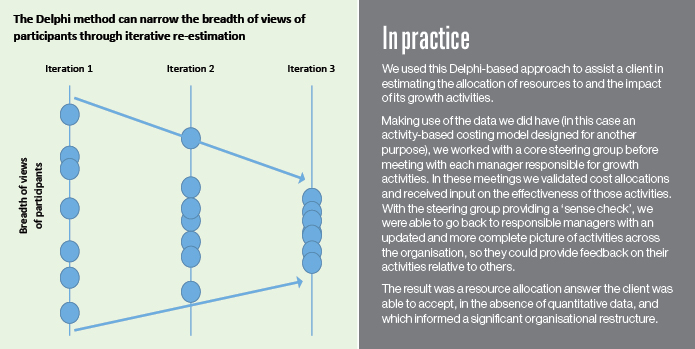Make informed decisions in the absence of a fact base
‘It doesn’t really matter whether you can quantify the results. What matters is that you can rigorously assemble evidence – quantitative and qualitative – to track your progress. If the evidence is primarily qualitative, think like a trial lawyer assembling a combined body of evidence.’
Collins, J, 2005, Good to great and the social sectors, Elements Design Group, California
By Brad McSwain
In a world that is so focused on data, where there is an expectation that every important business decision will be backed up by data, how can we confidently make informed decisions when it is seemingly absent?
Two principles have helped our clients make informed decisions in the absence if a deep fact base:
- Build a body of evidence
- Use consensus-building research methods
It seems as though in every issue of the most well-read management and technology publications and blogs there is an article on data: how big it is, how it can transform your business, how your competitors are using it to capture market share. And it’s true that there is an increasing wealth of data at our fingertips and it is becoming easier to manipulate and analyse.
But there are still times when we know we have a problem, it has our attention and is demanding a response, and yet we don’t have the data that we believe is needed to convince ourselves, our colleagues or our boards of the right response. This is most often the case when the problem would, in an ideal world, be readily quantifiable: where our growth will come from, how well we are retaining customers, how we best allocate our limited resources.
1. Build a body of evidence
As noted by Jim Collins, much like a lawyer making a case, a body of evidence can be assembled to overcome any limitations in or absence of data. In these circumstances, a single data-set may not be sufficiently compelling in-itself to convince; however, taken together, the body of evidence is.
Take a professional services firm which strives to have a positive social impact through the work it does with its clients. To quantify this through a single metric would require that metric to be widely accepted, reported on by all of this firm’s clients, and for the firm to have a thorough understanding of how the work it does impacts on its clients’ performances against this metric. This would be an extremely complex undertaking, and the benefits of knowing are unlikely to be outweighed by the costs involved.
Instead, the firm employee’s need only the answers to the following questions in order to be sufficiently satisfied they are having the impact they desire:
- Do our clients have a positive social impact?
- Are we helping our clients with their highest priorities?
- How significant an impact on our clients’ organisations is our work expected to have?
The answers to these questions can come from surveying a combination of clients, shareholders and employees, making it a low cost, frequently obtainable evidence base on which to assess the firm’s overall impact.
2. Use consensus-building research methods
There are challenges with using a body of evidence in place of accepted data. One challenge is where a decision stakeholder is unconvinced of a single component of the body of evidence, and uses this to be unconvinced of the whole body of evidence; another challenge is where a decision stakeholder believes that another, or a small number of, other decision stakeholders has had too much influence over the body of evidence. Both of these challenges require the use consensus-building techniques, more so than if accepted data is available and used.
One consensus-building technique which we have employed with success is based on the Delphi method developed by the RAND Corporation in the 1950s. The Delphi method takes the individual, typically anonymous input from a group of experts to estimate an answer. Through iterations, the experts are provided with a summary of the group’s answers and asked to revise their previous input, which leads to the group narrowing in on an answer that is acceptable to the whole group.
The next time you’re faced with an important decision without cold, hard data, consider whether you have, or can build, a body of evidence which is sufficiently compelling to make the decision. And in building the body of evidence, employ consensus-building techniques to obtain input for decision stakeholders so that they, too, will be convinced.
Want to know more?
If you would like Right Lane to help you make informed decisions, contact Marc Levy: marc@rightlane.com.au
Right Lane Review
This is article 1 from the June 2015 edition of Right Lane Review: Learning and growth. Full newsletter here.

